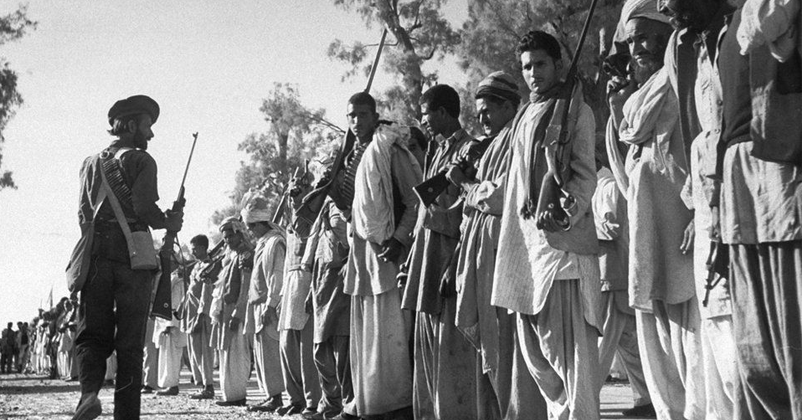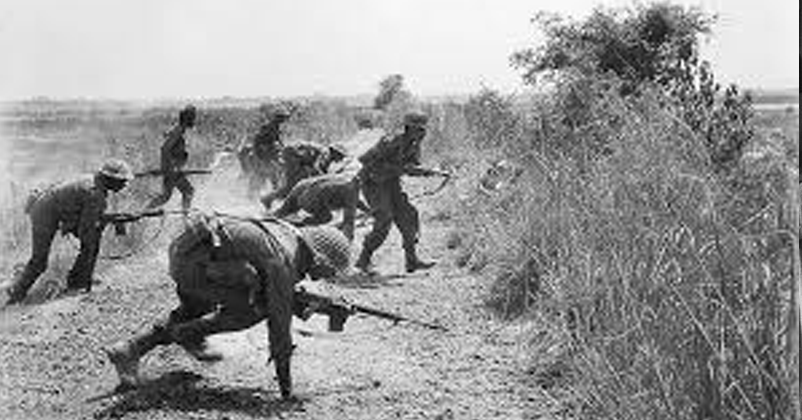History # Revision: How rattled Pakistan began invading Jammu and Kashmir in 1947; Part 4
| 23-Nov-2022 |

In a series of articles on Pakistan’s invasion of Jammu and Kashmir in 1947, we are bringing another chapter of that era in continuity with the earlier articles and the excerpts have been taken from "The history of Operations in Jammu and Kashmir 1947-48”.
Jammu Division under threat
Though by the recapture of Uri on 13 November 1947, the threat to Srinagar was removed, the situation in the Jammu Province had worsened considerably. The hostiles had seized a considerable stretch of territory close to the Pakistan border.
Early in October 1947 raids by ex-servicemen, armed with modern arms and equipment, had been carried out on the State Force garrisons deployed on that front. The size of these raids had varied from small parties of approximately ten to a hundred. The object of these raids had been to pin down the garrisons of the State army and also to serve as a feint for the main push along the Kohala-Srinagar road. The raids had well served their purpose, for they had led to a large scale rising of the turbulent Muslims on the Poonch and Mirpur borders, who were supplied with arms and ammunition by the raiding Pakistani forces.
By 15 October the raiders had penetrated into Poonch and Mirpur, surrounding some of the State Force garrisons and destroying others. The Muslim components of Jammu and Kashmir Forces in the Poonch-Mirpur sector had deserted on 18 October with arms and ammunition and joined the raiders. A few days later the hostiles had made their main push along the Kohala-Srinagar road. Whilst the main push had been in progress, all garrisons in Poonch and Mirpur had been encircled.
DISPOSITION OF THE STATE FORCES
The weak and isolated garrisons carried on a heroic, though unequal, struggle against heavy odds. Three weak brigades were deployed in the Poonch, Mirpur and Jammu sectors. In the Poonch sector, the Brigade Headquarters was at Poonch, one battalion(1J&K Inf)held Hajira and another (9 J&K) garrisoned Rawalkot while two companies of 7 J&K protected Bagh. In the Mirpur sector the garrisons were dispersed over a large area. Brigade Headquarters and one platoon were at Jhangar, while two companies held Naushahra; one battalion, supported by four medium machine guns and two mortars, garrisoned Kotli; one company protected Mirpur, two platoons held the forward post at Chechian; and Bhimbar was garrisoned by one squadron cavalry (horsed). There was a platoon at Munawwar and two platoons at Tharochi. The Jammu sector was held by Brigade Headquarters and one battalion (5J&K)group.

DESPATCH OF TROOPS
As priority was given by the Government of India to the task of saving Srinagar and the Jhelum valley, the State garrisons in Mirpur and Poonch sectors had perforce to be left to carry on unaided the struggle against heavy odds. But steps were taken to establish the line of communication between Pathankot and Jammu, and on 27 October, Army HQ (India) impressed on Lieut-General Dudley Russell, CB, CBE, DSO, MC, General Officer Commanding-in-Chief, Delhi and East Punjab Command, the necessity of establishing immediately the line of communication between Pathankot and Jammu. Next day they informed him that one brigade group would be despatched to Jammu as soon as possible under arrangements of Delhi and East Punjab Command.
The task of the force was to be as follows:-
i) To assist the Government of Jammu and Kashmir in maintaining law and order in the Jammu area.
(i) To keepopen line of communication from Jammu to Srinagar.
(ii) To reinforce the brigade group in Srinagar if necessary. Lieut-General Russell ordered two troops of armoured cars and infantry battalion of 50 Para Brigade to proceed immediately to Srinagar via Jammu and the rest of the brigade to concentrate in Jammu. The bridge-over the Ravi at Madhopur was not ready for use and the troops had to be ferried across the river. On 31 October, Headquarters 50 Para Brigade, two companies 3 (Para) Rajput and two companies 1/2 Punjab were concentrated in Jammu.
1/2 Punjab were flown that very day from Jammu to Srinagar. While troops were being rushed to Srinagar, 50 Para Brigade was getting ready to carry out its vital role of protecting the line of communication. Advance Headquarters 50 Para Brigade, 1 Patiala, 3 (Para) Rajput and ancillary troops concentrated in Jammu by November 4, the rest were expected to be in Jammu by 6 November.
The primary role of 50 Para Brigade was to keep open the road Madhopur-Kathua-Jammu-Srinagar for supplies to get through to Jammu and Srinagar. The secondary role was to maintain law and order in Jammu. The supply depot on which the Indian forces in Jammu and Kashmir were based was at Pathankot, and the only road from there to Srinagar was very vulnerable to attack from the raiders, as approximately 112 km of it ran along the Pakistan border and there were bridges, embankments and narrow gorges. On 4 November Brigadier Y.S. Paranjape, Commander 50 Para Bde, issued orders for the protection of the line of communication.
HOPES OF RELIEF FADE OUT
While 50 Para Brigade was busy protecting the line of communication and maintaining law and order in Jammu, the State Force garrisons in Poonch and Mirpur sectors had been running short of supplies and ammunition and were in urgent need of air supplies and air support. Bhimbar had fallen at 0400 hours on 28 October in an attack in which the raiders had used mortars and flame throwers. The ring around Mirpur was tightening. Kotli was heavily besieged. The garrisons of Bagh and Rawalkot in Poonch sector were hard pressed.
In view of this serious situation, the Military Adviser, J&K, had appealed to the Government of India on 28 October for immediate air support for the garrisons. Consequently, supplies had been dropped from the air on the garrison of Kotli on 28 October. No further action had been taken, except that one Tempest of No. 10 Squadron had taken off from Ambala on 1 November and had carried out a reconnaissance of Kotli area.
Air Headquarters had, however, on 31 October ordered an RIAF detachment to be formed immediately at Srinagar with 4 Spitfire and 4 Harvard aircraft to provide air support to the army in their operations. The Royal Indian Air Force detachment at Amritsar was to act as Advance Base for this detachment.
As the situation deteriorated, the Military Adviser, J&K, appealed to the Defence Minister of India (on 2 November) to expedite the dropping of supplies and ammunition on the hard pressed garrisons.
Air Headquarters, however, expressed their inability to undertake further drop commitments, as the air effort was concentrated on urgent support to forces in Srinagar. On the same day, Mehr Chand Mahajan, the then Prime Minister of J&K,made a fervent appeal to Nehru to save the State garrisons and thousands of refugees from being massacred. The latter asked Lieut-General F.R.R. Bucher, CBE, MC, officiating Commander-in-Chief, Indian army to take the matter into consideration.
Though the general view at the meeting of the Defence Committee of the Cabinet had been that it was difficult to give adequate help to the people marooned in Mirpur, Kotli and Naushahra, Nehru expressed his desire that some help should be rendered subject, of course, to the overriding necessity of not slackening on the main priorities in Kashmir. Next day, 3 November.1947, the matter was again taken up by the Defence Committee of the Cabinet.
General Bucher was of the view that it was undesirable to allow operations in Poonch and Mirpur sectors to affect the main operations in Srinagar. He expressed some concern about the safety of the Kashmir Valley, for the difficulties of maintaining troops in Srinagar in winter would be insuperable. It would not be possible to keep the Jammu-Srinagar road open throughout the winter by mechanical means or by human effort. Even if the snow was removed from the road, it was likely to remain ice-bound.
It was necessary, therefore, to send sufficient stocks into Srinagar to maintain the troops there for the three months that the road was likely to remain closed.It would be disastrous to slacken efforts to maintain the troops in Srinagar.
The Defence Committee, however, asked the Chiefs of Staff to prepare an appreciation of the long-term situation in Kashmir.
To be continued………